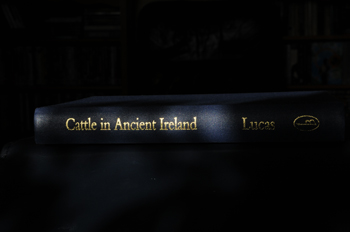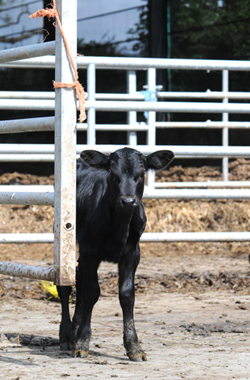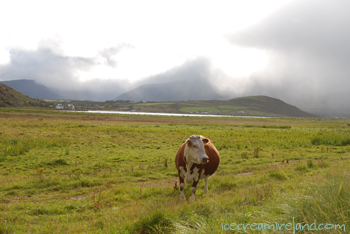 I’ve been working on an article on milk, which I think will be in next week’s Irish Times magazine. I did a fair bit of research, including reading a fascinating book, Cattle in Ancient Ireland, by A.T. Lucas. It’s amazing how intertwined milk cows are with Irish history, and our literature and historical tracts are full of cows. Professor Lucas writes, “It must be emphasised that these thousand of allusions (in ancient literature) are not to cattle in general but specifically to cows and more specifically to cows as yielders of milk. There are no beef-eating heroes in Irish literature; the doughtiest Irish warriors relied on pig-meat for their intake of protein.”
I’ve been working on an article on milk, which I think will be in next week’s Irish Times magazine. I did a fair bit of research, including reading a fascinating book, Cattle in Ancient Ireland, by A.T. Lucas. It’s amazing how intertwined milk cows are with Irish history, and our literature and historical tracts are full of cows. Professor Lucas writes, “It must be emphasised that these thousand of allusions (in ancient literature) are not to cattle in general but specifically to cows and more specifically to cows as yielders of milk. There are no beef-eating heroes in Irish literature; the doughtiest Irish warriors relied on pig-meat for their intake of protein.”
The importance of both cows and milk in Ireland is the basis for the article, along with my belief that we have the best milk in the world. Since there were far too many interesting tidbits in the book (and that was only one part of my research!) for a relatively short piece, I thought I’d put some of it here.
10 Things You Might Not Know About Cows and Ancient Ireland
1. The milk cow was the highest unit of currency under Brehon law, and Lucas writes, “The cow was the measure of everything: it was the unit of value; the ultimate in poverty was the man with only one cow; the wealth of the richest consisted of vast herds of them.”
2. There was a practise of bathing new-born infants in milk. St. Brigid was the daughter of a bondsmaid, and her mother was sent out to get milk, then “the maidservants washed St. Brigid with the milk that was still in her mother’s hand.”
In 1171, Henry II arrived in Ireland and insisted on reforms including that babies be baptised in churches. From the Chronicle of the Reign of Henry II: “For it was formally the custom in various parts of Ireland that immediately a child was born, the father or some other person immersed it three times in water and, if it was the child of a rich man, he immersed it three times in milk.” There us no suggestion that this bathing was a Christian baptismal rite.
 3. It seems there was a tradition of not letting the calves go to their mothers after the death of an important person, so that they, missing their mother, joined in the keening, or wailing. In Cogadh Gaedhel re Gallaibh, describing the death of Brian Boru’s brother, it states: “Calves are not suffered to go to the cows, in lamentation for the noble Mathgamhain.”
3. It seems there was a tradition of not letting the calves go to their mothers after the death of an important person, so that they, missing their mother, joined in the keening, or wailing. In Cogadh Gaedhel re Gallaibh, describing the death of Brian Boru’s brother, it states: “Calves are not suffered to go to the cows, in lamentation for the noble Mathgamhain.”
From the Annals of Ulster, under 737: “Cernach, son of Fogartach, is treacherously slain by his own wicked associates, whom the calves of the cows, and the women of this lower world in long continued sadness bewailed.”
4. Buachaill, the Irish word for boy, comes from cowherd.
5. It was believed that a cow deprived of her calf would retain her milk. There are many stories about calves being separated and what had to be done to get the mother to give milk (in one miracle, the wolf who killed a calf allows the cow to lick it as she would her calf, at which point the cow gives milk). So, much of dairying had to do with keep the calf close by and yet not letting it drink all the milk. Stuffed calf skins were used later on.
6. There was a strange tradition, recorded on the Iveragh Peninsula, that when cows became ill after calving (reducing their milk), women blew three puffs of their breath into the cow’s vaginia as a therapeutic treatment. This is echoed in Herodotus talking of the Scythians: “…they insert a tube made of bone and shaped like a flute into the mare’s genitals… and while one blows, another milks.” It’s also echoed in Al0’Ubaid, from 2500BC, where milkers are shown in profile sitting behind the cows with their mouths adjacent to the genital region of the animals.
7. Cattle were brought to burials. There is a reference in Annals of Connacht to Domhnall O Conchobhair, who was killed in 1307 and buried at Boyle Abbey, Co. Roscommon: “He was taken to the Curlieu hills, and never in that age was there brought with any corpse so many droves and flocks of cattle and companies of horse and food and mercenaries as we brough with him to his burial.”
 8. Cows not only defined wealth, but they were used as currency. They made up all or part of a bride-price. When a king of Tara married the daughter of the King of Offaly, he promised four score cows, two score at once, and two score not later than the next May Day.
8. Cows not only defined wealth, but they were used as currency. They made up all or part of a bride-price. When a king of Tara married the daughter of the King of Offaly, he promised four score cows, two score at once, and two score not later than the next May Day.
9. Poets charged for their work in cows. The law tract Uraicecht Becc details the payments due to various grades of poets for their poems, ranging from one cow to ten cows (which tells you how valuable poems were at the time!).
10. Cattle raiding was common place. After all, our great epic, The Tain, is about a cattle raid. Creach, a word said to have originally meant marking or branding, is used as a reference to both the raid itself and for the intended prey.
Oisin, lamenting the quiet life says:
No courting or hunting, the two crafts we looked forward to
no fighting no raiding, no learning of athletic feats.Gan bheit ag suirghe ag seilg
in dá cheird le a raibhe ar súil
gan deabaidh gan denamh creach
gan beith ag foghluim cleas luith.
Even the saints shared the plunder of raids. St. Caillin of Fenagh is depicted as insisting on a fat cow from every prey from each son of a king and chieftain.












Just don’t get my father started on the cow bride-price. He’ll tell you he had to hand over half a dozen of his best bullocks just to get rid of me!
Can’t believe you went so cheap! 😉
Fascinating post, thanks Kieran. Outside of farming, cows don’t often get the credit they deserve, except as sources of milk and meat. They’re also surprisingly photogenic animals!
I love The Táin in all its strange and rambling glory. You’re probably familiar with Louis le Brocquy’s illustrations…
Ancient Irish copyright law was based on cows. No really.
‘to every cow her calf and to every book its copy’.http://www.jameslamiell.com/blog/to-every-book-its-copy
Love this post and glad I stumbled onto your blog. Wish I could eat some of your wonderful Irish ice cream on this warm, sunny Southern California afternoon. Any flavor would do…
I’ve had some fun researching ancient Ireland, too, though focusing more on bread baking than on milk and its byproducts. Saint Brigid is a hero of mine, and I bet she would have loved a scoop of ice cream made from the milk of her beloved cows! She probably would have had a party and shared it with all the kids she could find!
The missus was very impressed with your icecream last summer. Have you thought of getting a PDO for Kerry milk products. I’m working on it for our Irish Moiled Beef